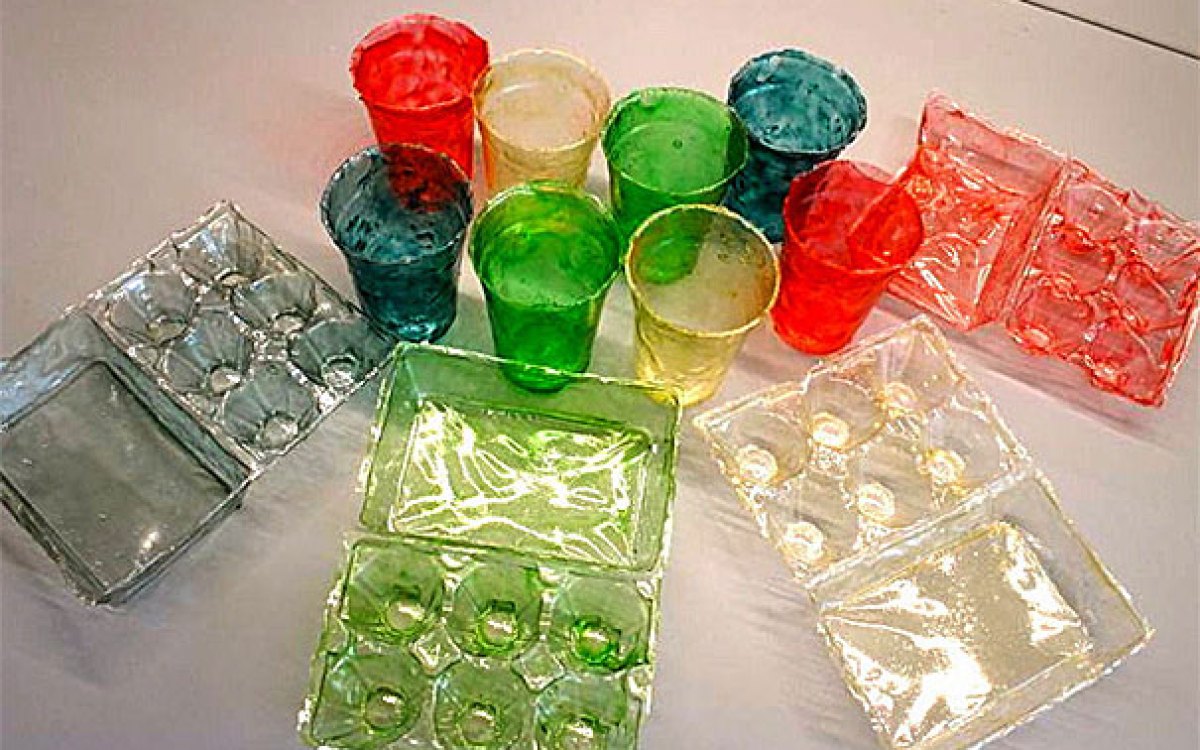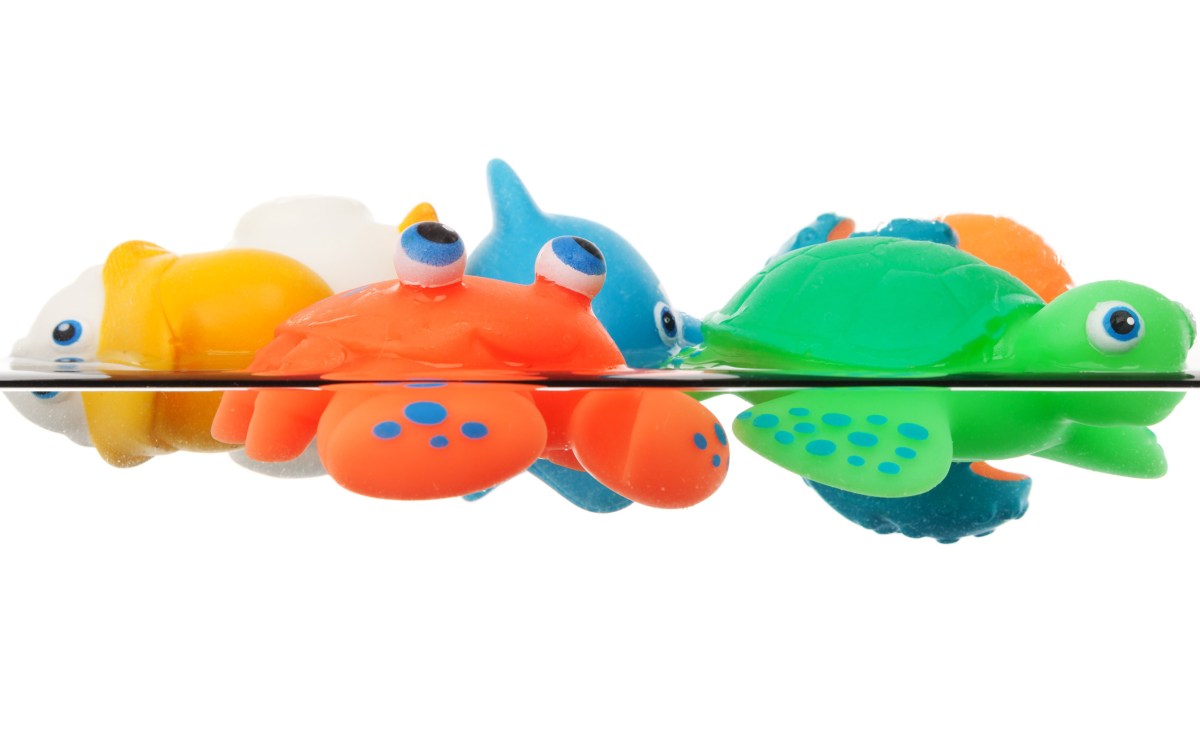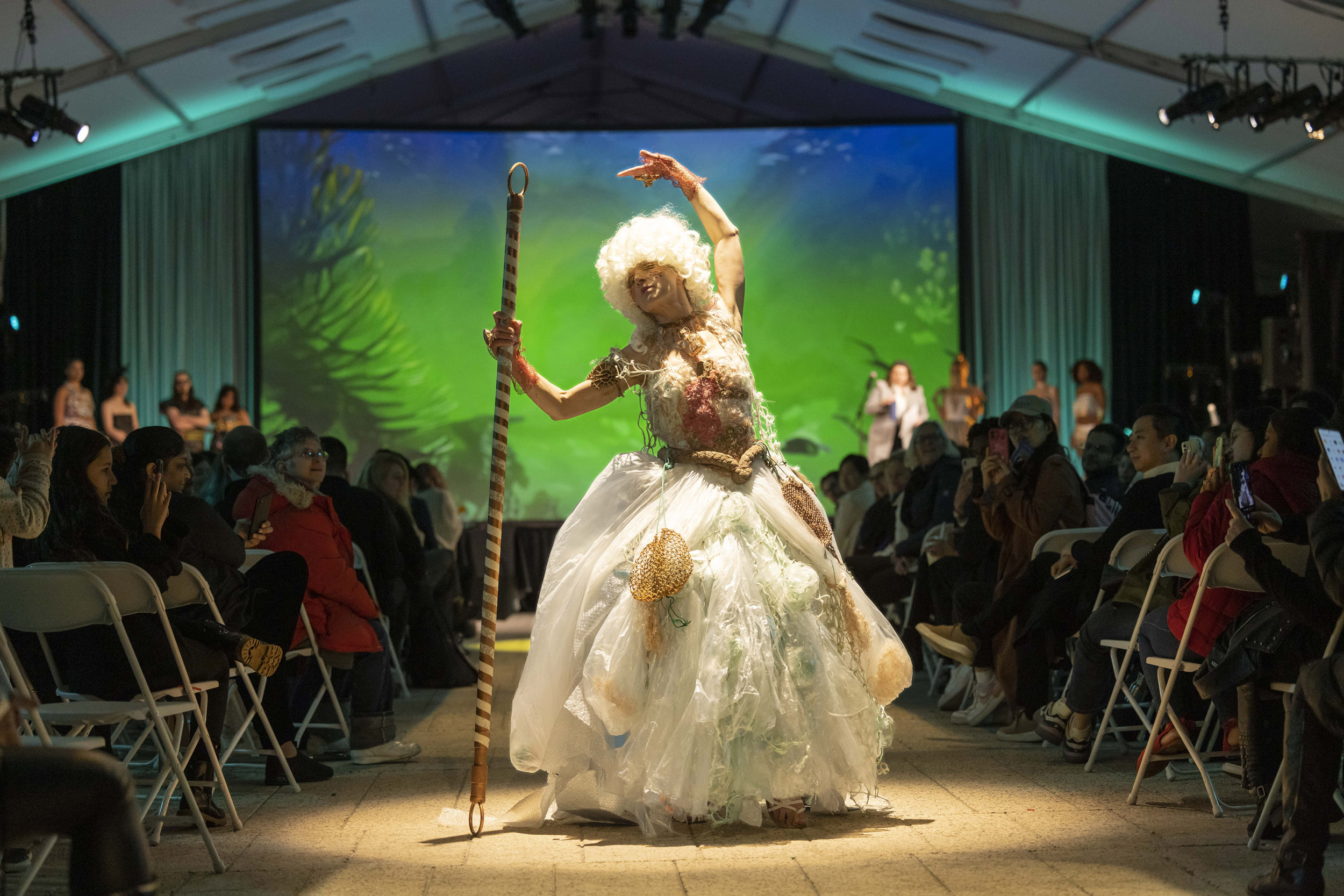
Gosia Sklodowska, associate director of the Center for the Study of World Religions, is wearing a skirt of plastic and bubble wrap. Her outfit was created by Ellen Vaillancourt, who collected some materials beachcombing in Revere and Winthrop.
Photos by Scott Eisen
Turning debris into haute couture
Harvard fashion show brings back ocean trash in the form of fashion
The fashions coming down the runway, glimmering under the stage lights, were as bejeweled and bright as any on a Paris runway. But the tube top was made from crushed soda cans, the chainmail miniskirt entirely of soda can pull tabs, and the decorations on a trash-bag dress were made from single-use coffee pods and red plastic cups.
Each model paused to strike a pose, allowing audience members time to hold up their smartphones and view augmented reality art: an octopus superimposed over one outfit, vines that appeared to be growing from another.
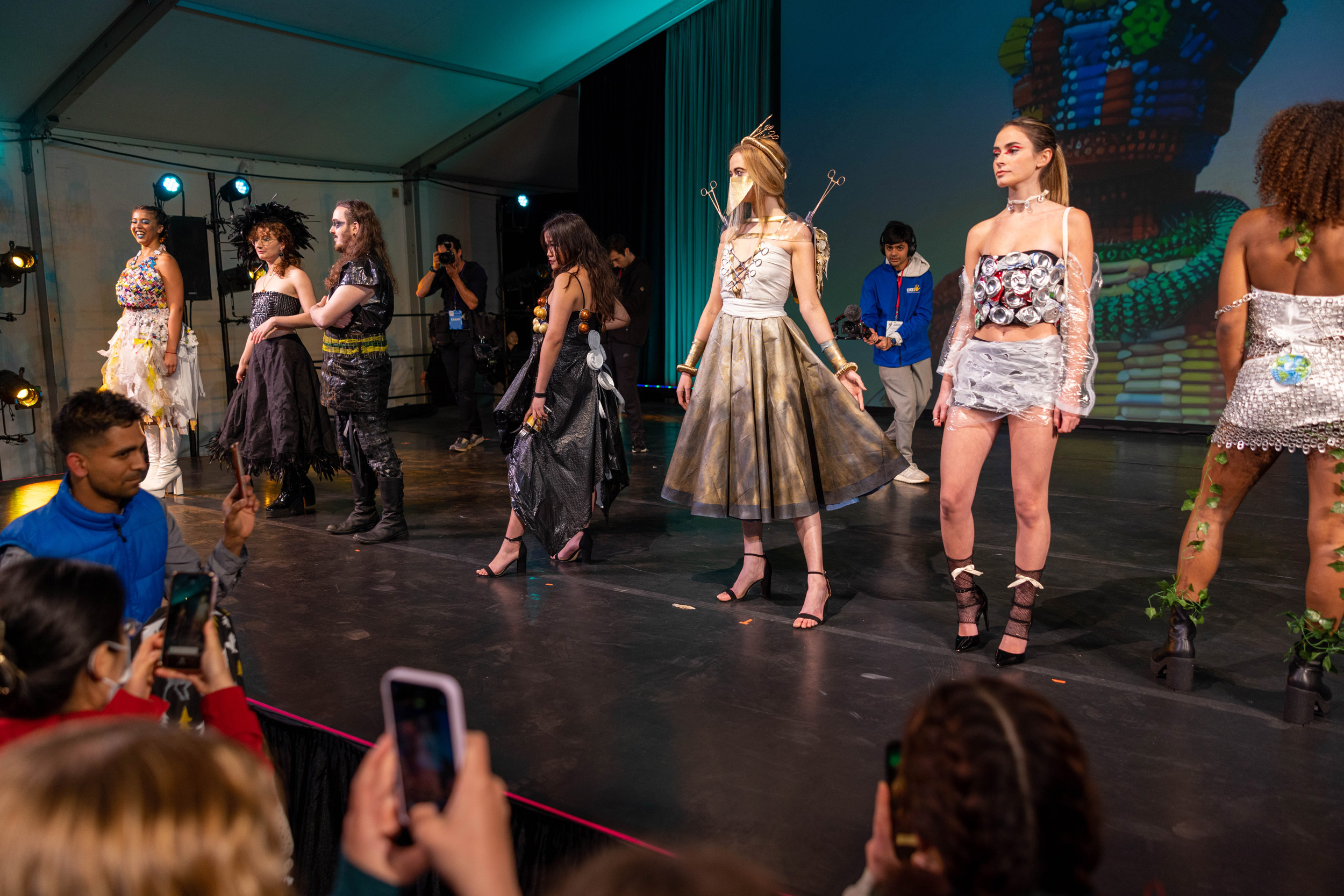
The event, titled the “Marine Debris Fashion Show,” was a design competition featuring outfits made from trash commonly found in oceans. Hosted by the Reimagining Experiential Education and Fabrication (REEF) Makerspace and the Lemann Program on Creativity and Entrepreneurship, the show was a highlight of 2023 Arts First Festival, Harvard’s annual public showcase of campus creativity, produced by the Office for the Arts.
The outfits were designed by students, who were given free rein with only one hard rule: None of their materials could be purchased new.
Makerspace Director Christine Braun, who organized the event alongside Director of Creativity and Entrepreneurship Sam Magee, said she hoped the show inspired creativity and also spread awareness about different waste streams.
“A lot of focus is on plastics, but we have fibers from fast fashion polluting our rivers and oceans,” Braun said. “I’m just hoping our audience members take a look at what our participants created, and, through our messaging, are a little bit more conscious of where our waste is going.”
For Harvard Divinity School student Ellen Vaillancourt, participating in the show was an opportunity to shine a light on the negative impact of polyester and poly-blend textile waste on the environment when fast fashion-clothing is thrown away.
“Clothing producers and consumers must intimately understand that there’s no such place as ‘away,’” Vaillancourt said.
Her outfit, titled “Water Is Life,” featured a voluminous white skirt of plastic and bubble wrap, hung with blue polyester fishing ropes resembling jellyfish, and draped in fishing nets. The bodice was decorated with pink and brown rope arranged to depict salmon spawning. The model also wore a white Baroque-style wig, a reference to colonial exploitation. Vaillancourt collected many of her materials while beachcombing in Revere and Winthrop.
“I think it’s so hidden, the devastation that is happening, the exploitation of human beings, mostly the labor of women and girls,” Vaillancourt said. “Nobody really understands that most of what is produced today, 70 percent is made of polyester or a poly-blend, that it doesn’t break down, or it takes an awfully long time, the amounts of toxins that it leaves, the degradation of the soil and the water. Ultimately, we’re eating our shirts.”
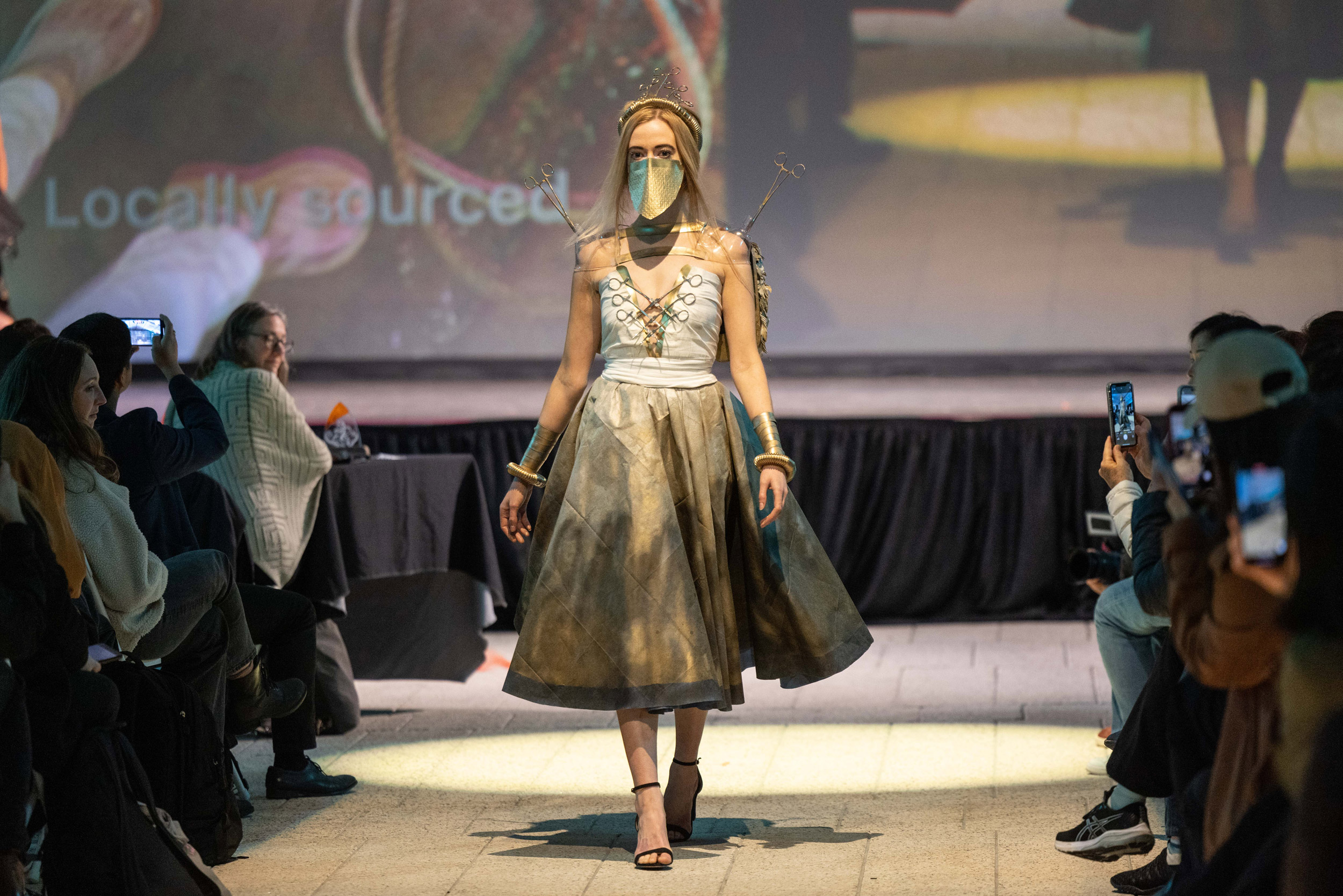
Harvard Medical School student Kelly O’Conor walked the runway in her outfit made from unused, expired medical supplies that she sourced from one of HMS’ area teaching hospitals.
O’Conor’s white and gold outfit, which she hand-sewed using suture needle and thread, featured a bustier bodice of cloth dressings adorned with metal forceps, and a painted skirt made from surgical gowns and draping. Her headpiece featured a band of ventilation tubing and a crown of forceps. On her back she wore a set of wings made from two bedpans decorated in feathers, attached to her shoulders with two oxygen masks.
Many sterile medical supplies, such as surgical tools and fabrics, carry expiration dates that require them to be discarded even if they are still unused. O’Conor said it’s important that equipment be in pristine condition, but wonders how many of the expiration dates are arbitrarily set, or can be avoided with greater care by hospitals when ordering new supplies. She also noted the irony of the fact that medical waste contributes to environmental pollution, which creates health risks.
“One of the reasons our lifespans have lengthened so much in recent decades is because we’ve become much better at protecting against infection,” O’Conor said. “The main point I wanted to get across was this paradox that exists in modern medicine. Effective sterility comes at a cost: massive amounts of waste. We seem to have found ourselves in a catch-22. The better we become at treating disease, the more we contribute to poor health outcomes long-term.”
A panel of judges represented various stakeholder groups, including the Office of Sustainability, Eleganza, Artivive, and the Professional Association of Diving Instructors. They awarded prizes for effective messaging and creative augmented reality additions. O’Conor’s design won the award for best material innovation, while Vaillancourt’s won an award for best haute couture.
Vaillancourt was happy with the prize, but even more appreciative of the message the show was sending.
“I think that by offering this paradoxical piece of beautiful trash, it leaves people to reflect on it and to be open to dialogue and question what it is all about,” Vaillancourt said.



